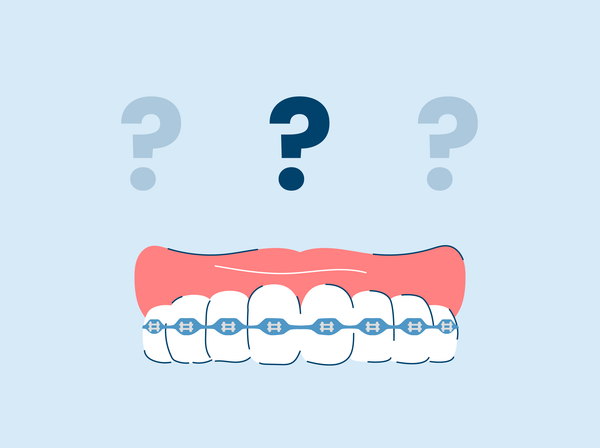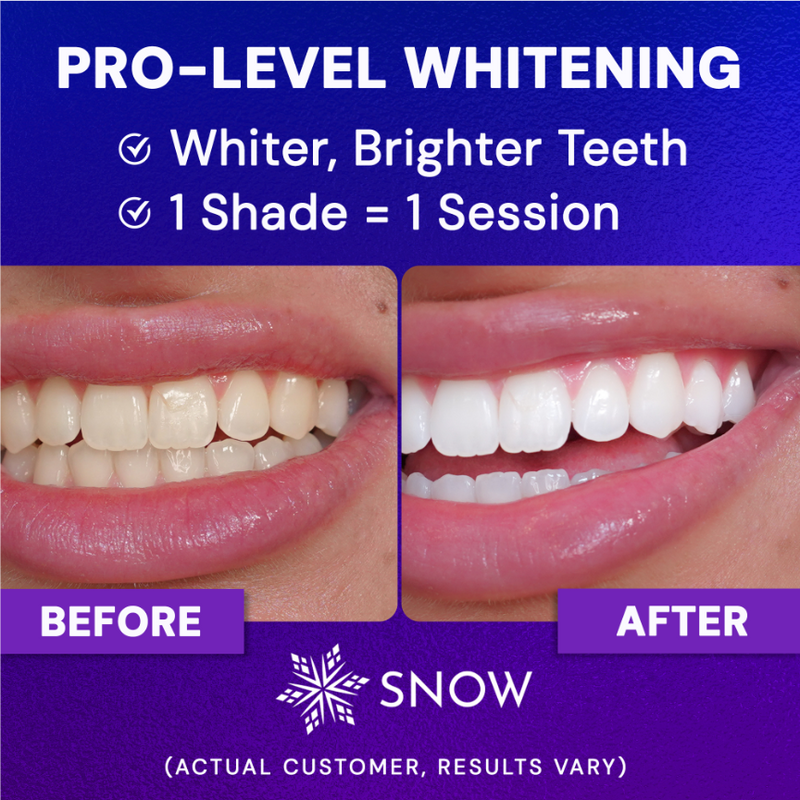Braces are an appliance that uses pressure to realign your jaw. They can aid in the prevention of gum disease, and jaw problems.
Small brackets get cemented to your teeth when you get traditional metal braces. A wire running through traditional brackets is threaded through and attached to your back teeth through many connected rings. This metal wire is adjusted regularly to help slowly shift your misaligned jaw into a new position.
If you're thinking about getting braces or if you already have them, you've probably heard of a power chain. This is a rubber or elastic chain that your orthodontist uses to apply additional force.
Continue reading to learn all you need about power chains including who might wear power chain braces, and other questions you may have.
WHAT ARE POWER CHAINS?
Power chains are ligature strings that are linked together (elastics). They are often constructed of the same material as the ligatures (the elastics holding the archwire to the individual brackets). Power chains can sometimes be formed of metal twists rather than elastic ones.
Unlike traditional elastics, which fit over each bracket separately, power chains link the brackets in a continuous band. These strands then connect to form a continuous ring of connected strings that spans your teeth. A power chain may be employed for certain teeth, while others may have standard ligatures around the brackets. Using ligatures and power chains allows orthodontists to address several treatment goals.
TYPES OF POWER CHAINS
Power chains and braces are not perfect products. There are more options beyond the obvious choices. And within those options, there are a variety of widths and lengths to design the power chain. The orthodontist will take an active role in determining the best kind for reaching clinical goals.
Power chains include closed, short, and long power chains. They all feature an adjustable width between each loop to suit the bracket they are mounted on.
WHAT ARE POWER CHAINS USED FOR?
Power chains are commonly used to narrow the distance between teeth. They can be utilized on existing spaced teeth or the gap left by tooth extraction. Power chains apply more pressure than brackets and archwires, making it simple to accelerate the treatment process.
Power chains can efficiently manage a variety of oral ailments, including:
- Straightening crooked teeth
- Alignment correction
- Malocclusions caused by rotating teeth
- Enhancing the dental midline
TREATMENT OBJECTIVES FOR POWER CHAIN BRACES
Power chain braces are utilized in a variety of treatments.
Closing teeth gaps: Power chain elastomerics are often utilized to fill gaps between teeth. Gaps can form spontaneously or as a result of orthodontic treatment.
Promote uniform spacing: Power chain elastomerics can be utilized to make your teeth more evenly spaced. This is frequently done when the teeth require additional dental operations such as fillings, crowns, or veneers.
Aligning crooked teeth: Power chain elastomerics exert steady pressure to realign crooked teeth gradually.
Rotating teeth: Power chain elastomerics can be utilized to turn rotatable teeth over time.
Bite correction: Power chain elastomerics can be used to correct your bite, particularly the way your top and bottom teeth come together when you close your mouth. Malocclusion, or tooth misalignment, can result from childhood activities like thumb sucking or tongue pushing.

HOW LONG WILL POWER CHAIN ORTHODONTIC TREATMENT LAST?
It depends on each situation, as with many other questions about the duration of braces therapy.
The length of therapy will vary depending on the individual, reflecting factors that affect braces cost.
Some will wear power chains for six months, while others may finish their therapy in six weeks.
Even after the specific reason for the power chains being used on the braces has been remedied (like closing a gap), the orthodontist may keep them on to prevent them from reverting—similar to how a retainer will.
SIDE EFFECTS AND RISKS
Power chains' hold on teeth weakens with time. This might be attributed to a variety of circumstances, including:
- The nature of the power chain.
- The precise material from which they have formed movement as a result of chewing food or moving your teeth.
- Environmental elements, like as moisture, temperature, and saliva contact
As a result, the orthodontist will need to replace the power chain with a new one periodically. This is something that may be done during a regular adjustment visit.
Overall, the dangers of power chains are comparable to the risks of wearing braces. They may include the following:
Food bacteria: Food might become caught in and around your dental braces, causing gum disease from poor oral hygiene habits. It can lead to plaque buildup if it isn't removed with brushing and flossing, which can cause some irritation and inflammation of gums.
Tooth decay: Tooth decay can also be caused by plaque accumulation. This can encompass the first stages of tooth decay and the progression to cavity development.
Teeth with short roots: Roots secure your teeth in the jaw. Because braces shift your teeth gradually, you may have short tooth roots compared to someone who did not get braces. This may result in less stable teeth.
Lost correction: Braces with power chains can align the teeth and jaw, if you do not wear your retainer after removing your braces, you may lose this curative effect.
ARE POWER CHAIN BRACES PAINFUL?
Will power chains hurt? The placement of connected ligatures is likely to cause discomfort in the early stages of treatment. However, this discomfort will fade over time, and you will feel no pain.
You will feel much better within a week in most cases. To avoid further irritation and suffering, you may need to eat softer foods until then. Power chain braces can be easily stained by foods such as curry, wine, and coffee. As a result, if you wear them, you should brush your teeth regularly after meals.
Your orthodontist will advise you on managing that time and minimizing pain, such as mild pain medication. The tenderness you're experiencing should pass quickly. For the duration of your orthodontic treatment, you must follow your orthodontist's dietary recommendations.
HOW SHOULD YOU LOOK AFTER YOUR POWER CHAINS
Maintaining your braces and power chains with good oral hygiene is critical for seamless therapy. Here are the same oral hygiene habits you would use with traditional braces to help you:
BRUSHING YOUR TEETH AFTER YOU EAT
Plaque might form due to food particles accumulating around your braces and power chain. Brush your teeth after each meal. If brushing isn't feasible, rinse your mouth with water or mouthwash.
GENTLY BRUSH
Use just a soft-bristled toothbrush. Brush your teeth gently to avoid putting strain on your braces and power chains.
FLOSSING
Flossing not only removes food lodged between your teeth, but it also aids in the removal of sticky invaders from your braces and power chain. The floss threader is a little yet helpful item that simplifies flossing with braces.
USE MOUTHWASH
Swallowing water entirely in your mouth after brushing and flossing might help eliminate any irritating trapped food particles. A rinse such as the SNOW Arctic Frost Mouthwash is an excellent option.
EXAMINE YOUR BRACES IN THE MIRROR
After washing your teeth, thoroughly inspect your braces and power chain in the mirror. Look for any broken or frayed threads.
CERTAIN FOODS SHOULD BE AVOIDED
Some foods can seriously harm your braces and power chain. As a result, it is recommended to avoid them and seek alternatives.
- Sticky foods can become stuck in braces and power chains.
- Biting onto hard foods such as corn on the cob or carrots might cause your braces or power chain to break.
- High-sugar foods can contribute to plaque buildup.
CONCLUSION
Power chain elastomerics are orthodontic appliances that are connected by a chain of elastic O-rings. They are simple to use and can serve multiple functions. These elastomerics can also correct various tooth alignment issues, such as crooked teeth, uneven spacing between teeth, rotated teeth, and malocclusions.
Power chain elastomerics can cause bacterial buildup, root resorption, pain, and other side effects. Taking proper care of your braces can help you achieve the best results with the least discomfort.
FAQS
WHAT DOES A POWER CHAIN DO ON BRACES?
Power chains are made of a malleable material and are made up of many linked rings. They are used in braces to apply more pressure to a specific part of your mouth. They are commonly used to close the gaps between teeth but can also aid in the alignment of your teeth.
ARE POWER CHAINS THE LAST STAGE OF BRACES?
During orthodontic treatment, power chain braces are used by orthodontists to close gaps between teeth. They like to use them to move teeth fast and to fill more significant spaces where a tooth may be missing, possibly due to extraction. It should be noted that power chain braces are often used near the end of treatment.
ARE POWER CHAIN BRACES BETTER?
The power chains on braces are highly efficient since they apply more pressure and force to the teeth than regular brackets and ligatures. Power chains and braces have been shown to efficiently attain tremendous results in a short time when used together.
DO POWER CHAIN BRACES WORK FASTER?
Power chains close gaps and provide more force to move teeth faster than elastic ligatures. It goes without saying that if you've had teeth extracted, you'll need them again.






































































